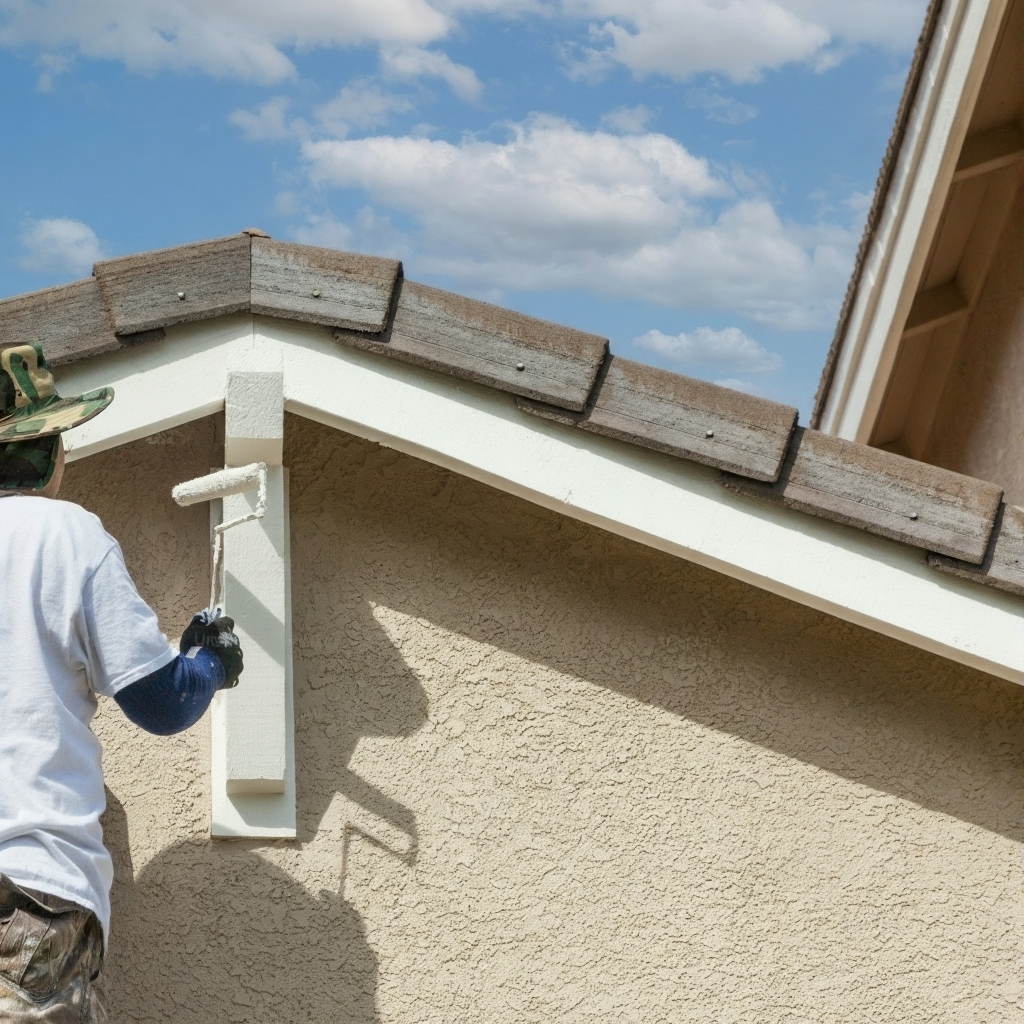
How to Prevent Roof Leaks During Florida’s Rainy Season 2025
Florida-Specific Roofing & Climate Challenges
November 2,2025
How to Prevent Roof Leaks During Florida’s Rainy Season 2025

Alt text: Florida homeowner working with professional roofer inspecting roof before rainy season, showing proactive maintenance and preparation
Florida’s wet season brings more than just afternoon thunderstorms. From May through October, your roof faces relentless rainfall, high humidity, and occasional tropical systems that can expose even the smallest vulnerability. A tiny crack today becomes a major leak tomorrow, and by then, the damage extends far beyond your shingles.
You don’t need to wait for water stains on your ceiling to take action. Understanding where leaks start and how to stop them before the rains arrive can save you thousands in repairs and give you genuine peace of mind when storm clouds roll in.
Early roof maintenance before rainy season starts can prevent 90% of water damage issues that plague Florida homes during peak wet months.
Understanding why Florida roofs leak during rainy season
Florida’s climate creates a perfect storm for roof deterioration. Constant moisture, intense UV exposure, and sudden temperature shifts work together to break down roofing materials faster than in most other states.
The most common leak sources include:
- Damaged or missing shingles that create entry points
- Deteriorated flashing around chimneys and vents
- Clogged gutters causing water backup
- Poorly sealed roof edges and fascia
- Weakened roof structure from prolonged moisture exposure
Your roof’s drainage system matters just as much as the covering itself. When gutters overflow or roof scuppers get blocked, water pools on your roof surface instead of flowing away. This standing water finds every tiny gap and works its way underneath your protective layers.
Understanding Florida’s rainy season patterns helps you time your maintenance correctly. The transition from dry to wet season happens quickly, leaving little room for last-minute preparations.
Essential pre-season roof preparation steps
You can’t fix problems you don’t know exist. A certified roof inspector identifies soft spots, damaged materials, and early signs of moisture intrusion that aren’t visible from the ground. They’ll check your attic for water stains, examine flashing integrity, and assess your roof’s overall readiness.
Schedule this inspection in April or early May, before the wet season rush. You’ll have time to complete repairs without competing for contractor availability.
Your gutters and downspouts need clear paths for water flow. Remove leaves, debris, and any vegetation growing in or around these systems. Check that downspouts direct water at least six feet away from your foundation.
Roof scuppers and drains on flat or low-slope sections require special attention. These can clog quickly during heavy rain, creating dangerous water weight on your roof structure.
Regular drainage maintenance takes 2-3 hours twice yearly but prevents thousands in water damage repairs.
Modern roof coatings create an additional waterproof barrier over your existing materials. Elastomeric sealants work particularly well for preventing coastal wind damage while also blocking water intrusion.
Consider these coating applications:
- Spray-on elastomeric coatings for comprehensive coverage
- Targeted sealants for flashing and penetrations
- Reflective coatings that reduce heat absorption
- Silicone-based products for flat roof sections
These coatings do more than prevent leaks. They extend your roof’s lifespan and can significantly reduce cooling costs by reflecting solar heat.
Pay special attention to roof edges, valleys, and anywhere two surfaces meet. These transition zones experience the most stress during heavy rain and wind events. Proper fascia installation and secure flashing prevent water from sneaking under your roofing materials.
If you notice any loose or damaged components, address them immediately. Small repairs now prevent expensive emergency fixes during a storm.
Choosing leak-resistant roofing materials
Not all roofing materials perform equally in Florida’s wet climate. Your choice affects both immediate leak resistance and long-term durability.
| Material Type | Water Resistance | Typical Lifespan | Best For |
|---|---|---|---|
| Metal Roofing | Excellent | 40-70 years | High rainfall areas |
| Tile (Clay/Concrete) | Very Good | 50+ years | Traditional aesthetics |
| Asphalt Shingles | Good | 20-30 years | Budget-conscious projects |
| Flat Roof Membranes | Excellent | 20-35 years | Low-slope applications |
Metal roofing systems, particularly standing seam designs, offer superior water resistance because they have no horizontal seams where water can penetrate. The interlocking panels create a continuous barrier that sheds water quickly.
Tile roofing works well in Florida’s climate when properly installed on a solid underlayment. The tiles themselves resist water absorption, but the installation quality determines overall performance. Choosing the right roofing material for Florida’s heat involves balancing water resistance with thermal performance.

Alt text: Professional roofer applying protective coating to Florida home roof to prevent leaks during wet season
Asphalt shingles remain popular due to lower initial costs, but they require more frequent maintenance in Florida’s intense climate. Modern architectural shingles with enhanced water-sealing technology perform better than traditional three-tab designs.
Your roofing material choice should account for both immediate water resistance and how well it handles high humidity conditions year-round.
Catching leaks early minimizes damage and repair costs. Watch for these indicators inside your home:
- Water stains on ceilings or upper walls
- Musty odors in attic spaces
- Peeling paint near rooflines
- Visible light through roof boards
- Sagging ceiling sections
Outside warning signs include missing shingles, curled tile edges, rust spots on metal components, and daylight visible through roof gaps. Storm damage signs can appear subtle at first but worsen rapidly once water finds an entry point.
Don’t ignore small drips or minor discoloration. These indicate active leaks that will expand with each rainstorm. Quick response prevents structural damage, mold growth, and electrical hazards.
Working with roofing professionals for Florida’s rainy season
Roof work during Florida’s wet season requires experience with regional challenges. Look for contractors who understand local building codes, Florida roofing regulations, and climate-specific installation techniques.
A qualified contractor will:
- Provide detailed written estimates
- Carry proper licensing and insurance
- Explain material options for your specific situation
- Offer warranties on both materials and workmanship
- Schedule work around weather forecasts
Foxhaven specializes in preparing Florida homes for rainy season challenges. Our team understands how coastal air affects roofing materials and implements proven solutions that withstand our unique climate conditions.
We handle everything from minor repairs to complete roof replacements, always focusing on long-term water resistance and structural integrity. Our experience with Florida’s weather patterns means we know exactly which preventive measures deliver the best protection for your investment.
You’ve learned where leaks start, how to prevent them, and which materials resist water damage best. Now it’s time to implement this knowledge before the next thunderstorm tests your roof.
Start with a professional inspection to establish your roof’s current condition. Address any identified problems immediately, focusing first on drainage and flashing issues. Consider protective coatings as an affordable insurance policy against water intrusion.
The investment you make in roof preparation pays dividends through avoided emergency repairs, extended roof lifespan, and protection of your home’s interior and contents. Regular roof inspections catch problems early when fixes remain simple and affordable.
Florida’s rainy season doesn’t have to mean roof anxiety. With proper preparation and quality materials, your roof can handle whatever weather comes your way. Take action now, before the clouds gather, and you’ll face the wet months with confidence instead of concern.
Ready to protect your home? Contact Foxhaven today for a comprehensive roof evaluation and customized leak prevention plan designed specifically for Florida’s challenging climate.
